Osteophies are basically intra-articular structures, generally within the joint capsule. Osteoarthritis is a progressive and degenerative disease that mainly affects the joints and bone in the body. It is caused by a number of pathogenic bone-formation disorders, including mechanical instability, osteoporosis, cartilage degeneration, osteophytes, and bone disease (including diffuse idiopathic osteoporosis and osteomalacia).
Osteoarthritis can affect any joint, but most commonly affects the hips, knees, and spine. Osteoporosis is a general term for any reduction in bone mass due to an aging process; the main cause of osteoporosis is hormonal changes.
Osteopathic treatment is aimed at treating the underlying cause of osteoarthritis and also preventing osteoarthritis from occurring in the first place. Osteoarthritis may be the result of numerous factors, such as poor diet, lack of physical activity, improper or excessive use of weight lifting equipment, or genetic factors. The treatment of osteoarthritis is normally directed towards treating the cause of the disease in order to slow or prevent further deterioration of the affected joint.
Osteoarthritis treatment usually aims to alleviate the symptoms and pain experienced by osteophytes and to increase the ability of osteoarthritis treatments to repair and repair damaged tissue. In more severe cases, nonsteroidal anti-inflammatory drugs such as ibuprofen or naproxen are often prescribed. Sometimes topical steroid injections are also given to reduce inflammation and reduce swelling in the joints. If the patient is unwilling to undergo joint replacement surgery, non-steroidal anti-inflammatory drugs can be prescribed for prophylactic purposes for a long period of time. It is important for osteophytes that the joints receive proper rest after treatment.

To reduce osteoarthritis pain in osteophytes, it is often necessary to remove as many osteophytes from the joints as possible
Sometimes this can be done by bandaging or removing the joints through a small incision. The joint can then be sent to a laboratory where osteophytes can be tested and destroyed. If the test proves that none of the osteophytes survived after a certain time, it is recommended to remove the osteophytes and use new bone material instead.
Treatment for osteoporosis can vary from person to person; this usually depends on the cause and extent of damage to the osteophytes in the joint. Osteoporosis treatment usually focuses primarily on reducing the risk of osteoporosis. Treatment includes strengthening bones to prevent future bone loss, anti-inflammatory drugs, surgery, and bone grafts. If the condition is genetic, osteoporosis can be treated with medication, surgery, and bone grafting.
Prevention of osteoporosis is important because osteoarthritis is usually caused by many different factors and therefore cannot be prevented altogether. Prevention of osteoarthritis also involves dietary changes, weight training, and exercise to strengthen the bones. In many cases, osteoarthritis can be prevented through proper diet and healthy lifestyle. This means avoiding tobacco use, excessive alcohol consumption, not using harmful weights lifting equipment, and getting sufficient amount of rest and exercise.
Osteoporosis is a degenerative disease of the bone that can occur at any age. Because of this, osteophytes should always be kept under constant surveillance. Osteoporosis is one of the most common and serious forms of osteoporosis that affects millions of people around the world. Although the treatment of osteoporosis is not curative, it can greatly slow down the progression of the disease and improve the quality of life for the person suffering from osteoporosis. If an osteophyte is diagnosed with osteoporosis, the first thing to do is get an osteopath to come and take a look at the condition of the bone structure, the symptoms of the ailment, and any pre-existing complications.